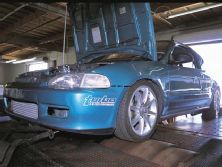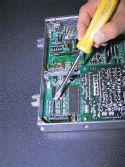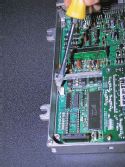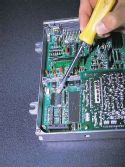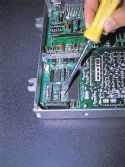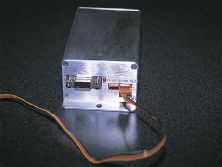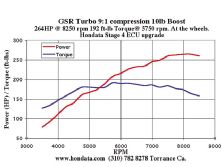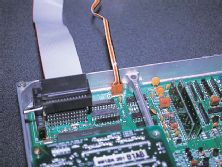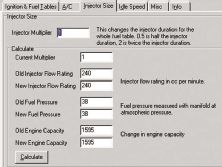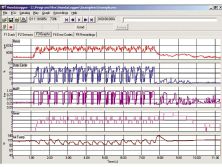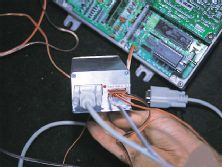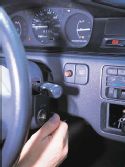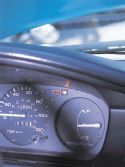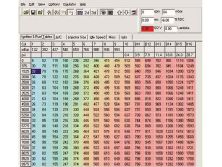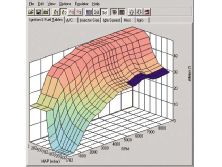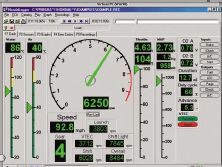Honda ECU codes are read in hexadecimal formula. Right now, you're probably wondering, "Heck-a-what!?" Programming in a Honda ECU is broken down into codes that put the challenge to electronics gurus while overwhelming the average enthusiast. Where most stand-alone units have fuel and timing maps broken down in to milliseconds on injector time and actual timing degrees on the ignition side, Honda chose to employ a hexadecimal numbering system. Let me ask you this: If you saw a 2B cell in a timing map, how would you know what it represents? Simple, it stands for 22 degrees of timing. At least those of you who are electronics wizards are saying that's an easy one. Most of our readers are do-it-yourselfers and are used to the standard stand-alone coding. Rather than reprogramming a Honda ECU, they would take the clearest path and rip out the brain and OEM wiring harness and replace it with a stand alone ECU and universal wiring harness. Remove no more people, because Hondata has "de-scrambled" Honda's hexadecimal system and made programming the Honda ECU a reality--one that won't break the bank.
Rather than wiring in an aftermarket wiring harness, modifications need to be made to the ECU. Hondata provides detailed instructions on installing the necessary parts to open a line of communication with the factory ECU. Tools needed are a soldering iron, solder wick or a solder sucker and solder. The vehicle's ECU determines what hardware needs to be installed.
The Hondata system comes in four different stages from the basic rev limiter removal to a full-blown engine management system complete with data logging capabilities. Stage I consists of removing the rev-limiter and raising speed limiter using a Hondata ROM and ROM socket, as well as an ECU-controlled shift light. No fuel and timing mods are added. Stage II adds a VTEC controller capable of switching the VTEC fuel and timing maps within the ECU using the interface box. Stage III adds a two-step rev limiter for drag launching, which also incorporates the use of the Hondata interface box. The Stage IV brings the ECU to a programmable state via laptop computer. Promoting this unit as a tuning device, we are going to go into the software provided with the Stage IV configuration.
Fuel & Timing
With fuel and timing tables simplified, programming with the Hondata software is identical to programming most stand-alone units. Number values are shown in milliseconds for fuel and actual degrees of timing for timing cells. Unlike most stand-alone units, Hondata allows for calibrating two separate high- and low-speed maps for VTEC-equipped powerplants.
Fuel mapping is consistent with OEM size as far as resolution is concerned, but the major advantage is the Hondata's ability to compensate for fuel tuning under boost. In normally aspirated trim, the map has a total of 200 cells for the low-speed map and an additional 200 for a high-speed map. The low-speed map is designed with a 10x20 format. The high-speed map is also set up as a 10x20 with rpm starting at 3500 rpm. There are 10 columns designated for atmospheric pressure and 20 rows for rpm. The unit can measure vacuum in millibar (mbar), kilopascal (kPa) and inches. For a boosted application, the tuner has the choice to view pressure in millibar, kilopascal, bar (bar), kilograms per square centimeter (kg/cm2) and pounds per square inch (psi). In a boosted application, rather than taking away resolution from vacuum to compensate for the added boost adjustments, the Hondata unit will add an additional 60 cells (3x20) to compensate for up to 11 psi of boost pressure. If boost pressure exceeds 11 psi, the user also has the ability to add an additional 60 cells expanding boost resolution to 6x20 (120 cells). Hondata offers a three bar replacement sensor to make use of the additional boost, since the factory MAP sensor can only calibrate up to 12 psi. Tuning adjustments are executed in plus or minus one percent increments. The software also allows for group changes. Rather than change each cell one by one, the tuner has the ability to highlight a region of the map and make a percentage change throughout the entire highlighted area. There are plans for the software to be upgraded with map tracing. In doing so, changes can be made to the most affected area of the map.
Timing maps work in the same way as the fuel tables, but cell numbers are actual timing degrees for the specific rpm/cm Hg. The Hondata unit can make timing changes in quarter to full degree increments. Mapping sizes are identical to fuel tables only the data is shown in timing degrees.
With 20 available rows of rpm and 10 columns of vacuum, resolution can be lost in between rpm and vacuum. An example would be how you can adjust rpm at the 4000 rpm point and the next row down would be 4500. What the Honda ECU does is interpolate between these to points by taking an average of the four surrounding cells to come up with a smooth transition between the rows of rpm and columns of vacuum. Since there is a big jump between both rpm and the measurement of vacuum the software will figure out the correct compensation.
The Hondata unit also allows for injector and fuel pressure changes. If a user has programmed a unit to control 240cc injectors, yet they have upped the size of the injectors, the user has the ability to compensate for the difference in size. Of course, fine-tuning has its benefits, but this compensation allows the tuner to cut down tuning time. The ROMEditor software is also capable of changing fuel mapping, if fuel pressure changes, by punching in the before and after pressure changes.
Electronic Dash
Using a laptop computer and the Hondata interface box, the user has the ability to pull up an electronic dash that shows all the engine vitals. The electronic dash views all ECU sensor inputs and outputs. This can be used to either view sensor inputs and outputs for tuning purposes or it can be used as a trouble shooting device by checking correct voltage inputs and outputs.
The Stage IV Hondata unit is also equipped with datalogging capabilities galore. Since the factory sensors provide the engine information for fuel and timing parameters, Hondata decided to use this information for data logging purposes. The factory sensors deliver voltage signals to the ECU and the Hondata ECU converts the signals into a readable output (turning voltage signals into temperature and pressure readings). Not only is the unit able to record engine parameters, it is also able to read vehicle speed and gear changes through the OE speed sensor. A total of 48 channels of information can be sampled. The user-friendly software allows the tuner to scroll through the different channels and select what kind of data they want recorded, based on the engine's sensor readings. Sampling varies on the number of channels used, but record time is 6 hours. For precision diagnosing, the recorded information can be zoomed in or out for specific analysis.
Hondata basically took the factory ECU, which has a processor in OE trim and beefed it up with datalogging capabilities and the power to change fuel and timing curves. Eliminating the need to rewire a harness to use a stand-alone ECU and simplifying the programming in the ECU enables Hondata to sell the unit at a very low price. Hondata is also willing to do the modifications needed to get the programming started.
For more information, please visit http://www.hondata.com
 | The Ultimate Code Breakers
| The Ultimate Code Breakers

